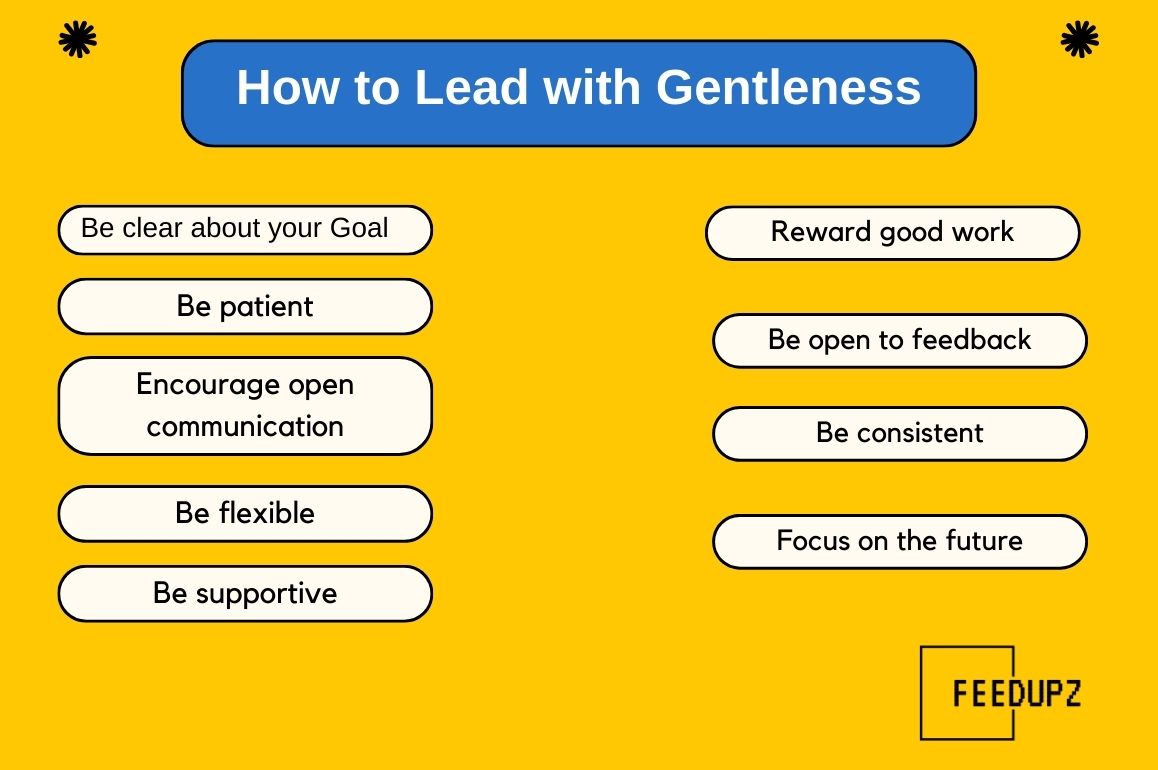There is a wide range of leadership styles, as some leaders choose to be authoritarian, while others prefer collaborative and inclusive methods. A leadership approach that has become acknowledged and favored is gentle leadership.
Compassionate leadership prioritizes empathy, kindness, and understanding, alongside maintaining authority and driving outcomes. This article will investigate the concept of gentle leadership, the significance of gentleness in a leader, techniques for leading with gentleness, and the advantages of this leadership approach for companies.
What is Gentle Leadership?
Gentle leadership emphasizes compassion, humility, and empathy as key components of its leadership style. It means taking the lead with kindness, empathy, and regard for others, fostering a caring and empowering atmosphere.
Kind leaders aim to create solid connections with their team members and motivate them with positive feedback and support. Open communication, collaboration, and inclusivity are important to them. Emotional intelligence holds great importance at the core of kind leadership.
As mentioned by Kendra Cherry, an expert in psychosocial rehabilitation, emotional intelligence consists of different components: self-awareness, self-control, empathy, drive, and interpersonal abilities. These elements play a crucial role in the leadership approach, allowing leaders to effectively connect with their teams.
The Importance of Gentleness in Leadership
Several reasons make gentleness essential in a leader. Above all, it establishes a favorable and supportive work atmosphere that makes employees feel appreciated and encouraged. By being gentle in their leadership approach, leaders build trust and create a psychologically safe environment for employees to freely share their ideas and concerns.
Moreover, being gentle encourages successful communication and teamwork. A caring leader pays close attention, recognizes different viewpoints, and shows understanding in their responses. This method promotes open communication and improves team cohesion, resulting in higher levels of creativity and innovation.
Furthermore, being gentle in one’s leadership style contributes to the growth and support of talent across the organization. Gentle leaders support team members by acknowledging their strengths and potential, offering guidance for personal growth and professional advancement.
How to Lead with Gentleness
There are many methods in which gentle leadership can be integrated into the workplace. Here are some suggestions on how you can accomplish this:

1. Be clear about your Goal:
Your team must understand the objective and the significance behind it. Clarify your goals and ensure that all individuals are involved and aligned.
2. Be patient:
Not everything will go as expected, and that is perfectly fine. Maintain patience as your team strives for success and avoid becoming frustrated by imperfections.
3. Encourage open communication:
Effective communication is essential in all corporate positions, but as a compassionate leader, you may need to promote it more actively. Ensure that all individuals are at ease when expressing their thoughts, and pay attention to their perspectives.
4. Be flexible:
There is not a universally effective method for leadership, so be prepared to adjust your style as necessary. If something is not effective, be open to experimenting with new approaches.
5. Be supportive:
It is crucial to support your team members when they make mistakes. Provide support and guidance to assist them in gaining knowledge from their errors in order to keep progressing and evolving.
6. Reward good work:
Inform your team members when they perform well. A small amount of acknowledgement can be very powerful in inspiring individuals to perform at their highest level.
7. Be open to feedback:
Being receptive to feedback from your team members is crucial. Not only does it assist in enhancing leadership skills, but it also demonstrates a willingness to listen to and learn from others.
8. Be consistent:
In order for your team to respect you, it is important to maintain consistency in both your words and actions. If they perceive you as frequently changing your mind or reneging on your word, individuals will rapidly lose trust in you.
9. Focus on the future:
Remaining focused on your goals is crucial, so avoid becoming overwhelmed by daily tasks. Stay focused on the goal and keep pushing ahead.
The Most Efficient Leadership Style
Identifying the most effective leadership approach may vary based on organizational culture, industry, and individual choices. Various leadership styles may prove to be more successful depending on the situation. Still, mild leadership has proven to be very successful in various circumstances.
Gentle leadership focuses on working together, building trust, and empowering employees, resulting in increased employee satisfaction, engagement, and productivity. This type of leadership encourages team members to take ownership and responsibility, creating a positive work environment that supports personal and organizational development.
Misconceptions about Gentle Leadership
Forbes claims that there are misunderstandings about gentle leadership that need to be addressed. In general, people often view gentle leadership as passive and lacking strength. Nevertheless, this is not true, as these leaders can ensure individuals are responsible for their actions and make difficult decisions regarding issues within the organization. The Forbes article also mentions the importance of balancing power with compassion and confronting obstacles directly. Finally, the focus remains on fostering connections and motivating growth as compassionate leaders effectively address issues.
Why Gentle Leadership is Good for Business
Gentle leadership offers several benefits for businesses:
- Increased employee motivation and satisfaction: Leaders who practice gentleness are able to cultivate a positive and supportive atmosphere at work, which in turn enhances employee morale and job satisfaction. This results in increased employee retention and decreased turnover as a consequence.
- Improved productivity and performance: Caring leaders support their team members, nurture innovation, and promote teamwork. This results in improved productivity, greater innovation, and better quality work results.
- Enhanced teamwork and collaboration: Soft leadership encourages transparent communication, trust, and inclusiveness. It fosters an environment of working together and teamwork, enabling efficient problem-solving and group decision-making.
- Stronger employee engagement: When employees are appreciated, backed, and listened to, they are more likely to be dedicated and involved in their job. Kind leaders establish a culture that encourages and excites their team, leading to increased levels of involvement.
Read More: Top 8 Personal Development Tips for Successful Business Owners
Gentleness in Leadership is Not About Fragility or Being Passive
It’s important to recognize that being gentle in leadership doesn’t mean being fragile or passive. A kind leader can also be confident, make difficult choices, and ensure that people are responsible.
The important thing is to find a harmony between power and kindness and to address obstacles and disagreements with empathy and comprehension. Kind leaders can handle problems in a firm and constructive manner while still prioritizing relationship-building and growth.
Effective Leadership Is Gentle
Successful leadership requires more than just having power and influence. Gentle leadership acknowledges the importance of empathy, kindness, and understanding in guiding and motivating others. By adopting a gentle approach to leadership, leaders can foster a positive work environment, cultivate talent, and attain remarkable outcomes.
Being a Gentle Leader
To be an effective leader, one must possess self-awareness, engage in ongoing education, and authentically strive to comprehend and assist others. By embracing the tenets of kind leadership, leaders can motivate their teams, encourage teamwork, and establish an environment of progress and achievement.
Conclusion
Compassion, generosity, and comprehension are all components of soft leadership. When leaders utilize them, it allows them to cultivate positive work atmospheres, establish strong connections, and motivate team members. Gentle leadership at the organizational level enhances the productivity, employee engagement, and team collaboration of the business.
FAQs
1. Can gentle leadership be effective in all industries and organizations?
Yes, a gentle approach to leadership can prove to be successful in every sector and company.
Although certain industries may demand assertive or directive leadership styles at times, the values of gentleness – including empathy, kindness, and collaboration – can still be incorporated into leadership approaches. Adapting the leadership style to the situation and prioritizing relationship-building and creating a positive work atmosphere is crucial.
2. Is gentle leadership suitable for handling conflicts or disciplinary actions?
Definitely, Calm leadership can effectively manage conflicts and disciplinary situations.
It requires facing issues positively and productively, while also taking into account the welfare and development of those involved. Soft leaders can address conflicts by showing understanding, actively listening, and seeking solutions that benefit all parties involved. When it comes to imposing consequences for misbehavior, gentle leaders can uphold respect and dignity, providing a fair and supportive disciplinary process for everyone involved.
3. Does gentle leadership mean leaders cannot make tough decisions?
No, having a kind leadership style does not imply that leaders are unable to make difficult choices.
Even though gentle leaders value empathy and understanding, they are able to make tough decisions when needed. The important thing is to find a balance between being authoritative and compassionate, and to make decisions openly and respectfully. Compassionate leaders can justify difficult decisions and offer assistance to those impacted, all while prioritizing the creation of a positive and developmental atmosphere.

